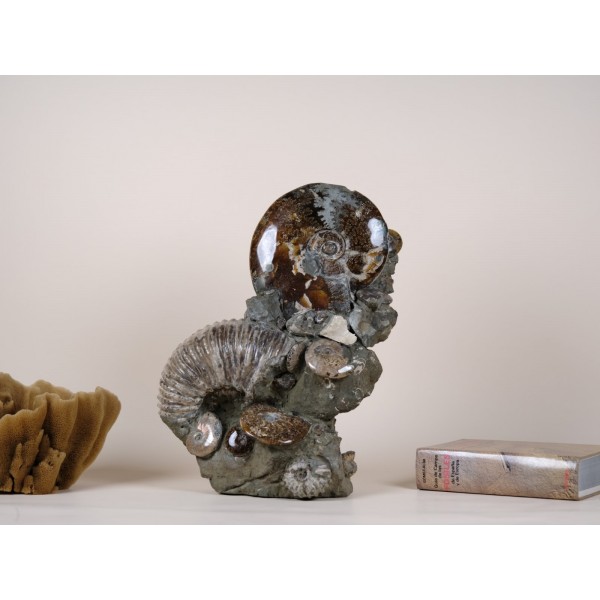Deltablastus permicus fossil
A great echinoderm Blastoide, from East Timor Permic beds, in an exotic tecula wood base.
Deltablastus permicus in matrix, from the Permiam period (circa 250 million years).
| close |
This shop uses cookies to improve your experience on our website. |
Reference: N1223
Cretaceous Albian period (100 to 145 million years) from Madagascar.
Spectacular big size opalized Cleoniceras group with other ammonite specie.
One of a kind decor piece!
Dimensions: 45,5 cm x 37 cm x 18 cm
Weight: 17 Kg

Cretaceous Albian period (100 to 145 million years) from Madagascar.
Spectacular big size opalized Cleoniceras group with other ammonite specie.
One of a kind decor piece!
A great echinoderm Blastoide, from East Timor Permic beds, in an exotic tecula wood base.
Deltablastus permicus in matrix, from the Permiam period (circa 250 million years).
Coelacanth Devonian Fossil Nodule
This well-preserved specimen is a Lower Triassic (247 million years old) Coelacanth fossil from the Karoo Formation of Madagascar.
It is encapsulated within a concretion that has been meticulously split into perfect halves. While various types of fossilized fish are discovered in these nodules, Coelacanths are among the rarer specimens in the fauna. The specimen exhibits incredible detail, showcasing fins, scales, and the distinctive bony head structure.
This exceptional piece is elegantly presented in a natural marble vertical display.
Madagascar Copal Amber with leaves and insects in a handmade brass base.
Amber is a substance derived from resins (Fossil Resin) of trees and plants that, buried for millions of years, underwent into a fossilization process.
These resins produced by plants acted as protection against the action of bacteria and against the attack of insects that punctured the bark until reaching the interior of the trees.
Over millions of years, amber-forming organic substances ended up forming a hardened, weather-resistant resin.
Hand-Polished Petrified Wood Bowl crafted by local artisans. This unique bowl showcases petrified wood from the Araucaria species, dating back 220 million years to the Early Triassic period. Meticulously polished by hand, the bowl features stunning patterns and colors inherent to the petrified wood.
Sourced from the Tsingy de Bemaraha National Park in Madagascar.
Phacops sp. from the Middle Devonian period ( 395 million years ) of the Djebel Issoumour area, Atlas Mountains - Morocco.
Prepared and restored, excellent for beginner collectors or as decor piece, in a black lacquered wood pedestal.
Nicaisolopha nicaisei from Upper Cretaceous of Cajamarca Peru, mounted in a white lacquered wood base.
Ammonite sliced - Cristal clusters - mounted on a handmade brass stand.
Aioloceras besairie (>140mm) Lower Cretaceous, Albian (100.5–113.0 million years), from Mahajanga, Madagascar.
These ammonite sliced in two parts has been polished for showing the breathtaking inside colors and patterns.
Side table with petrified wood and three double handmade brass legs.
Top of the table is a slice of petrified tree - Araucaria species with 220 million years from Early Triassic period, with beautiful pattern and very dark color.
It comes from the Tsingy de Bemaraha National Park in Madagascar.
One of a kind piece.
Sperm whale fossil teeth from the Miocene period ( 23 to 5 million years ) of USA.
Beautiful rare decor piece, mounted in a black lacquered wood base.
Kranaosphinctes rabei ammonite fossil, a testament to the Jurassic period's ancient splendor. This remarkable specimen hails from the Andangovato region, dating back an astonishing 160 million years to the Middle Jurassic period. It was discovered in Sakaraha, Madagascar.
Boasting both impressive size and impeccable quality, this specimen exhibits no repairs or alterations, making it a true collector's gem. Its sheer magnitude and pristine condition make it an ideal centerpiece for decor or a prized addition to the collection of even the most discerning enthusiasts.
The Kranaosphinctes rabei ammonite is not merely a fossil; it is a living testament to Earth's ancient past, a true masterpiece of natural history.
Perisphinctes sp. Ammonite from late Jurassic Period (160 million years), mounted in a exotic Tacula wood base.
Beautiful natural composition, from Sakahara fields in Southwestern Madagascar.
Cretaceous Albian period (100 to 145 million years) from Madagascar.
Spectacular big size opalized Cleoniceras group with other ammonite specie.
One of a kind decor piece!
An exceptional Museum Quality slab with five Gigantopecten restitutensis fossil from Vaucluse quarry in S.E. France.
Lower Miocene (Burdigalien), around 20 to 16 million years.
It is very well prepared and clean, a "one of a kind" piece!
A huge, beautiful coloured Douveilliceras mammilatum from the Albian period, Upper Cretaceous (110 million years) of Mahajanga Province - Madagascar.
A perfect piece for decor, mounted in a handmade wood base.
Orthoceras column fossil, a captivating relic hailing from a time more than 400 million years ago. These prehistoric squid-like beings, preserved through eons within oceanic sediments, offer an unparalleled glimpse into the past. Elegantly aligned by primordial currents on the ocean floor prior to their entombment, these creatures maintain their relative positions, frozen in the embrace of time.
Skillfully revealed through meticulous exposure and a masterful polish, the fossils come to life against their matrix backdrop. The artful interplay of light and shadow accentuates the delicate features of these long-extinct cephalopods. With their tentacles and ink sacs, reminiscent of their modern-day squid counterparts, these creatures possessed a mystique that transcends eras. Notably, these cephalopods boasted external shells, characterized by hollow internal chambers partitioned by intricate walls known as septa, a fascinating trait shared by their kin.
Originating from the Devonian period approximately 410 million years in the past, this fossil bears witness to the eons that have passed, finding its origin amidst the rugged landscapes of the Anti-Atlas Mountains in Southern Morocco.
Cretolamna Aschersoni in matrix, in acrylic base.
Beautiful Lamna Aschersoni shark teeth in their natural matrix, from Cretaceous era (66.0–145.0 million years) - Oued Zem – Morocco.